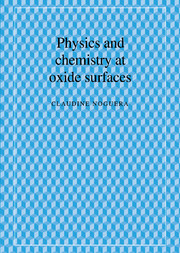4 - Surface excitations
Published online by Cambridge University Press: 24 September 2009
Summary
A semi-infinite crystal supports specific excitations which are not present in the bulk material. In oxides, these new modes result from the breaking of anion–cation bonds at the surface, whose effects on the electronic and atomic structure have been the subject of the two previous chapters. Here, we will describe the excitations associated with the atomic and electronic degrees of freedom. The phonons, which are the quantized modes of vibrations of the atoms, have small characteristic energies, of the order of a few tens of milli-electron volts (meV). The electron–hole pairs and plasmons, which are characteristic of the electronic degrees of freedom, have much higher energies, of the order of a few electron-volts. Due to the different time scales involved, a decoupling between these two types of excitations takes place (Born–Oppenheimer decoupling). The electrons are able to follow ‘instantly’ the atomic displacements, while the atoms have no time to move at the time scale of the electron delocalization and excitations.
Surface phonons
We have seen in Chapter 2 that bond-breaking on a surface greatly modifies the atomic energy levels. The same is true for the atomic vibrations around the equilibrium positions. In this section, we will review the main experimental and theoretical results concerning surface phonons on oxide surfaces.
Experimental and theoretical approaches
High-resolution electron energy loss (HREELS = high-resolution electron energy loss spectroscopy) experiments and inelastic scattering of helium atoms allow a determination of the surface vibration modes and of the phonon dispersion curves.
- Type
- Chapter
- Information
- Physics and Chemistry at Oxide Surfaces , pp. 106 - 127Publisher: Cambridge University PressPrint publication year: 1996

